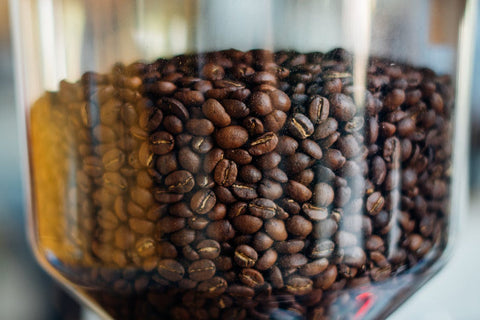Whether you have a manual coffee grinder or an electric coffee grinder, knowing how to properly clean and maintain it is essential for preserving the quality of your coffee.
The Importance of Properly Maintaining Your Coffee Bean Grinder
One of the main reasons why grinder maintenance is crucial is the presence of oils in coffee beans. These oils can build up over time and leave a residue on the grinder's burrs or blades, resulting in a stale and rancid taste in your coffee.
Furthermore, a clean grinder helps avoid cross-contamination between different coffee beans. If you use different types of beans, such as flavoured or decaf, cleaning the grinder between uses ensures that the flavours don't mix and alter the taste of your coffee.
Common Issues with Coffee Bean Grinders
1. Uneven Grind: One common issue with grinders is an inconsistent grind size. This can result from worn-out burrs or blades, improper adjustment settings, or a lack of cleaning. An uneven grind affects the extraction process and can lead to over-extraction or under-extraction, ultimately impacting the taste of your coffee.
2. Clogging: Clogging occurs when coffee grounds get stuck in the grinder, preventing a smooth and continuous grinding process. This can happen due to a fine grind setting, oily beans, or a lack of cleaning. Clogging not only affects the performance of your grinder but also makes it challenging to achieve a consistent brew.
3. Dull Burrs or Blades: Over time, the burrs or blades in your grinder can become dull, resulting in a less efficient grind. Dull burrs or blades may produce inconsistent particle sizes and require more time to achieve the desired grind. Regular maintenance helps keep your burrs or blades sharp, ensuring a consistent and efficient grind.
Cleaning and Maintaining Your Coffee Bean Grinder
Proper cleaning and maintenance are essential for keeping your coffee bean grinder in optimal condition. The frequency of cleaning depends on how often you use your grinder. For regular home use, a thorough cleaning every few weeks is typically sufficient.
Choosing the Right Cleaning Method for Your Grinder
There are several cleaning methods you can choose from, depending on the type of grinder you have and your personal preference. Here are a few common methods:
1. Manual Cleaning: This method involves disassembling your grinder and manually cleaning each component. It allows for a thorough and deep clean, ensuring that all coffee grounds and oils are removed. Manual cleaning is suitable for both manual and electric grinders, but it requires more time and effort.
2. Grindz Cleaning Tablets: Grindz cleaning tablets are specially designed to clean coffee grinders. These tablets are easy to use and effectively remove coffee residue and oils. Simply run the tablets through your grinder, following the manufacturer's instructions. Grindz tablets are a convenient option, especially for electric grinders.
3. Rice Cleaning: Some coffee lovers use uncooked rice to clean their grinders. While this method can remove coffee residue, it's not recommended. Rice is harder than coffee beans and can damage the burrs or blades in your grinder. It can also leave behind starchy particles that may affect the taste of your coffee.
Tips for Extending the Lifespan of Your Coffee Bean Grinder
Taking care of your coffee bean grinder goes beyond regular cleaning. Here are some additional tips that can help extend its lifespan:
1. Avoid Overloading: It's important not to overload your grinder with too many coffee beans at once. Overloading can strain the motor and cause it to overheat or wear out more quickly. Always follow the manufacturer's recommendations for the maximum amount of coffee beans.
2. Store Properly: When not in use, store your grinder in a dry and cool place. Avoid exposing it to excessive moisture or direct sunlight, as these can damage the internal components. Proper storage helps prevent corrosion and prolongs the life of your grinder.
3. Use High-Quality Beans: Using high-quality, freshly roasted coffee beans not only enhances the taste of your brew but also reduces the strain on your grinder. Fresh beans are less oily and produce less residue, resulting in cleaner and more efficient grinding.

Best Practices for Grinding Coffee Beans
Grinding coffee beans is a crucial step in the coffee brewing process. To achieve the best results, it's important to follow some best practices when grinding your beans. Here are a few tips:
1. Grind Size: Different brewing methods require different grind sizes. Adjust your grinder's settings accordingly to achieve the desired grind size. Coarser grinds are ideal for French press or cold brew, while finer grinds are suitable for espresso or pour-over.
2. Grind Fresh: For the freshest and most flavourful coffee, grind your beans just before brewing. Ground coffee starts to lose its aroma and flavour quickly, so it's best to grind only what you need for each brew.
3. Consistent Grind: Ensure that your grinder delivers a consistent grind by regularly checking the particle size. Uneven particle sizes can result in an uneven extraction, affecting the taste of your coffee. Adjust the settings as needed to achieve a consistent grind.
Troubleshooting Common Grinder Problems
Even with proper maintenance, you may encounter some issues with your coffee bean grinder. Here are a few common problems and their potential solutions:
1. Uneven Grind: If your grinder is producing an inconsistent grind, check the burrs or blades for any signs of wear or damage. Replace them if necessary. Additionally, ensure that the grind size is properly adjusted for your brewing method.
2. Clogging: If your grinder frequently clogs, consider using less oily beans or adjusting the grind size to a coarser setting. Regular cleaning will also help prevent clogs caused by coffee residue.
3. Dull Burrs or Blades: If you notice a decrease in grinding efficiency, it may be time to replace the burrs or blades. Dull burrs or blades can result in slower grinding and an inconsistent grind size.
Upgrading Your Coffee Bean Grinder
If you find that your current grinder no longer meets your needs or that you want to explore more advanced features, upgrading to a new grinder may be the solution. Consider factors such as grind consistency, capacity, speed, and ease of use when selecting a new grinder.
Investing in a high-quality grinder can significantly enhance your coffee brewing experience, providing you with precise control over your grind and ultimately resulting in a better cup of coffee.
With a well-maintained grinder, high-quality beans, and attention to detail, you can elevate your coffee brewing experience to new heights.


